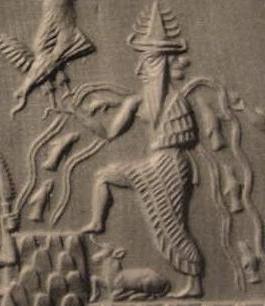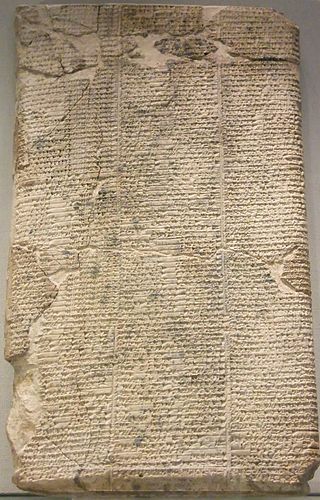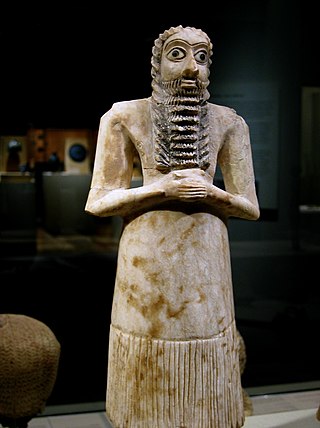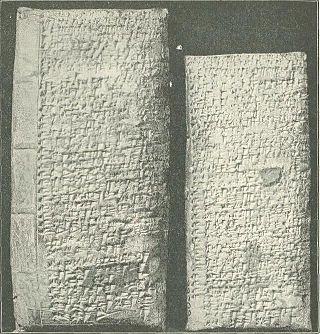| Part of a series on |
| Ancient Mesopotamian religion |
|---|
 |
The "Debate between sheep and grain" or "Myth of cattle and grain" is a Sumerian disputation and creation myth, written on clay tablets in the mid to late 3rd millennium BC.
| Part of a series on |
| Ancient Mesopotamian religion |
|---|
 |
The "Debate between sheep and grain" or "Myth of cattle and grain" is a Sumerian disputation and creation myth, written on clay tablets in the mid to late 3rd millennium BC.
Seven "debate" topics are known from the Sumerian literature, falling in the category of 'disputations'; some examples are: the Debate between Winter and Summer; the Debate between bird and fish; the Tree and the Reed; and The Dispute between Silver and Copper. [1] These topics came some centuries after writing was established in Sumerian Mesopotamia. The debates are philosophical and address humanity's place in the world.
The first sixty-one lines of the myth were discovered on the University of Pennsylvania Museum of Archaeology and Anthropology catalogue of the Babylonian section, tablet number 14,005 from their excavations at the temple library at Nippur. This was translated by George Aaron Barton in 1918 and first published as "Sumerian religious texts" in "Miscellaneous Babylonian Inscriptions", number eight, entitled "A New Creation Myth". [2] The tablet is 5 by 2.6 by 1.25 inches (12.7 by 6.6 by 3.2 cm) at its thickest point. Barton describes the text as an "elaborate statement of the non-existence of many things once upon a time" and considered it a "statement that mankind was brought into existence through the physical union of a god and a goddess."
Another tablet from the same collection, number 6893 (part of which was destroyed) was translated by Edward Chiera in 1924 increasing the text to seventy lines in "Sumerian religious texts". [3] Chiera compiled his translation using further tablets translated by Hugo Radau published in "Miscellaneous Sumerian Texts" in 1909. [4] Stephen Herbert Langdon also translated further parts of the text and discusses the myth saying, "One of the most remarkable tablets in the Museum is number 14005, a didactic poem in 61 lines on the period of pre-culture and institution of paradise by the earth god and the water god in Dilmun". [5] [6] [7] It was then increased to two hundred lines and the myth called cattle and grain by Samuel Noah Kramer in 1959; he called it the "second myth significant for the Sumerian concept of the creation of man". [8] [9] He added the translation of a tablet by Hermann Hilprecht [10] and included translations of museum tablet numbers 7344, 7916, 15161 and 29.15.973. He also included translations from tablets in the Nippur collection of the Museum of the Ancient Orient in Istanbul, catalogue numbers 2308, 4036 and 4094. [9] Other translations were taken from Edward Chiera's "Sumerian Epics and Myths" numbers 38, 54, 55, 56 and 57. [11] In total, seventeen pieces were found by Kramer to belong to the myth. Later work has added to this and modern translation has removed the deification of Lahar and Ashnan, naming them simply "grain" and "sheep" (also known as cattle). [12]
The story opens with a location "the hill of heaven and earth" which is discussed by Chiera as "not a poetical name for the earth, but the dwelling place of the gods, situated at the point where the heavens rest upon the earth. It is there that mankind had their first habitat, and there the Babylonian Garden of Eden is to be placed." [3] The Sumerian word Edin, means "steppe" or "plain", [13] so modern scholarship has abandoned the use of the phrase "Babylonian Garden of Eden" as it has become clear that the "Garden of Eden" was a later concept. [13] Jeremy Black suggests that this area was restricted for gods, noting that field plans from the Third Dynasty of Ur use the term hursag ("hill") to describe the hilly parts of fields that are hard to cultivate due to the presence of prehistoric tell mounds (ruined habitations). [14]
Kramer discusses the story of the god An creating the cattle-goddess, Lahar, and the grain goddess, Ashnan, to feed and clothe the Anunnaki, who in turn made man. [1] Lahar and Ashnan are created in the "duku" or "pure place" and the story further describes how the Anunnaki create a sheepfold with plants and herbs for Lahar and a house, plough and yoke for Ashnan, describing the introduction of animal husbandry and agriculture. [15] The story continues with a quarrel between the two goddesses over their gifts which eventually resolves with Enki and Enlil intervening to declare Ashnan the victor. [15]
Samuel Noah Kramer has noted the parallels and variations between the story and the later one of Cain and Abel in the Bible Book of Genesis (Genesis 4:1–16). [16] Ewa Wasilewska mentions, "this text is not very clear, allowing for the interpretation that humankind was already present before Lahar and Ashnan were created and it was them, not the Anunnakû, who were not able to provide for themselves and for the deities until they were given divine 'breath' (Lyczkowska and Szarzynska 1981). However, it seems that Kramer's translation is more appropriate concerning the Sumerian realm in which each and every creation must have had its clearly described purpose". [17] Karen Rhea Nemet-Nejat noted the use of measuring rods in the tale as being linked to the history of writing, which developed in order to keep count of animals and produce. [18] Jeremy Black suggests that the victory of grain perhaps implies that man can live without domestic animals, but cannot survive without bread. He goes on to point out that the debates on both sides are roughly equal. [19]
The introduction to the myth reads:
When, upon the hill of heaven and earth, An created the Annunaki, since he neither spawned nor created Grain with them, and since in the Land he neither fashioned the yarn of Uttu (the goddess of weaving) nor pegged out the loom for Uttu—with no Sheep appearing, there were no numerous lambs, and with no goats, there were no numerous kids, the sheep did not give birth to her twin lambs, and the goat did not give birth to her triplet kids; the Annunaki, the great gods, did not even know the names Grain or Sheep. There was no grain of thirty days; there was no grain of forty days; there was no grain of fifty days; there was no small grain, grain from the mountains or grain from the holy habitations. There was no cloth to wear; Uttu had not been born—no royal turban was worn; lord Niĝir-si, the precious lord, had not been born; The god of wild animals had not gone out into the barren lands. The people of those days did not know about eating bread. They did not know about wearing clothes; they went about with naked limbs in the Land. Like sheep they ate grass with their mouths and drank water from the ditches. [12]

The benefits that grain and sheep bring to the habitation are also described:
They brought wealth to the assembly. They brought sustenance to the Land. They fulfilled the ordinances of the gods. They filled the store-rooms of the Land with stock. The barns of the Land were heavy with them. When they entered the homes of the poor who crouch in the dust they brought wealth. Both of them, wherever they directed their steps, added to the riches of the household with their weight. Where they stood, they were satisfying; where they settled, they were seemly. They gladdened the heart of An and the heart of Enlil. [12]
The final merits of grain are emphasized in a proverb at the end of the myth:
From sunrise till sunset, may the name of Grain be praised. People should submit to the yoke of Grain. Whoever has silver, whoever has jewels, whoever has cattle, whoever has sheep shall take a seat at the gate of whoever has grain, and pass his time there. [12]

Enlil, later known as Elil and Ellil, is an ancient Mesopotamian god associated with wind, air, earth, and storms. He is first attested as the chief deity of the Sumerian pantheon, but he was later worshipped by the Akkadians, Babylonians, Assyrians, and Hurrians. Enlil's primary center of worship was the Ekur temple in the city of Nippur, which was believed to have been built by Enlil himself and was regarded as the "mooring-rope" of heaven and earth. He is also sometimes referred to in Sumerian texts as Nunamnir. According to one Sumerian hymn, Enlil himself was so holy that not even the other gods could look upon him. Enlil rose to prominence during the twenty-fourth century BC with the rise of Nippur. His cult fell into decline after Nippur was sacked by the Elamites in 1230 BC and he was eventually supplanted as the chief god of the Mesopotamian pantheon by the Babylonian national god Marduk.

Enki is the Sumerian god of water, knowledge (gestú), crafts (gašam), and creation (nudimmud), and one of the Anunnaki. He was later known as Ea or Ae in Akkadian (Assyrian-Babylonian) religion, and is identified by some scholars with Ia in Canaanite religion. The name was rendered Aos in Greek sources.

Ziusudra of Shuruppak is listed in the WB-62 Sumerian King List recension as the last king of Sumer prior to the Great Flood. He is subsequently recorded as the hero of the Eridu Genesis and appears in the writings of Berossus as Xisuthros.
Ashnan or Ezina was a Mesopotamian goddess considered to be the personification of grain. She could also be called Ezina-Kusu, which lead to the proposal that the goddess Kusu was initially her epithet which only developed into a distinct figure later on. She was already worshiped in the Uruk period, and appears in documents from many Mesopotamian cities from the third millennium BCE. She is also known from various works of Mesopotamian literature, such as the debate poem Debate between Sheep and Grain.

The Lament for Ur, or Lamentation over the city of Ur is a Sumerian lament composed around the time of the fall of Ur to the Elamites and the end of the city's third dynasty.
Lahar was a Mesopotamian deity associated with flocks of animals, especially sheep. Lahar's gender is a topic of debate in scholarship, though it is agreed the name refers to a female deity in a god list from the Middle Babylonian period and to a male one in the myth Theogony of Dunnu.
Eridu Genesis, also called the Sumerian Creation Myth, Sumerian Flood Story and the Sumerian Deluge Myth, offers a description of the story surrounding how humanity was created by the gods, how the office of kingship entered human civilization, the circumstances leading to the origins of the first cities, and the global flood.

The "Debate between bird and fish" is an essay written in the Sumerian language on clay tablets, dating back to the mid to late 3rd millennium BC. It belongs to the genre of Sumerian disputation.

George Aaron Barton was a Canadian author, Episcopal clergyman, and professor of Semitic languages and the history of religion.

The Barton Cylinder, also known as CBS 8383, is a Sumerian creation myth, written on a clay cylinder in the mid to late 3rd millennium BCE, which is now in the University of Pennsylvania Museum of Archaeology and Anthropology. Joan Goodnick Westenholz suggests it dates to around 2400 BC.

The Debate between Winter and Summer or Myth of Emesh and Enten is a Sumerian creation myth belonging to the genre of Sumerian disputations, written on clay tablets in the mid to late 3rd millennium BC.

Enlil and Ninlil, the Myth of Enlil and Ninlil, or Enlil and Ninlil: The begetting of Nanna is a Sumerian creation myth, written on clay tablets in the mid to late 3rd millennium BC.

The Old Babylonian oracle is a Sumerian myth, written on clay tablets dated to between 2340 and 2200 BC.

Self-praise of Shulgi is a Sumerian hymn dedicated to the Third Dynasty of Ur ruler Shulgi, written on clay tablets dated to between 2100 and 2000 BC.

The Kesh temple hymn, Liturgy to Nintud, or Liturgy to Nintud on the creation of man and woman, is a Sumerian tablet, written on clay tablets as early as 2600 BCE. Along with the Instructions of Shuruppak, it is the oldest surviving literature in the world.

The Hymn to Enlil, Enlil and the Ekur (Enlil A), Hymn to the Ekur, Hymn and incantation to Enlil, Hymn to Enlil the all beneficent or Excerpt from an exorcism is a Sumerian myth, written on clay tablets in the late third millennium BC.

The Decad is a name given to a standard sequence of ten scribal training compositions in ancient Sumer.

Miscellaneous Babylonian Inscriptions is a 1918, Sumerian linguistics and mythology book written by George Aaron Barton.

The Song of the hoe, sometimes also known as the Creation of the pickaxe or the Praise of the pickaxe, is a Sumerian creation myth, written on clay tablets from the last century of the 3rd millennium BCE.

The concept of a garden of the gods or a divine paradise may have originated in Sumer. The concept of this home of the immortals was later handed down to the Babylonians, who conquered Sumer.